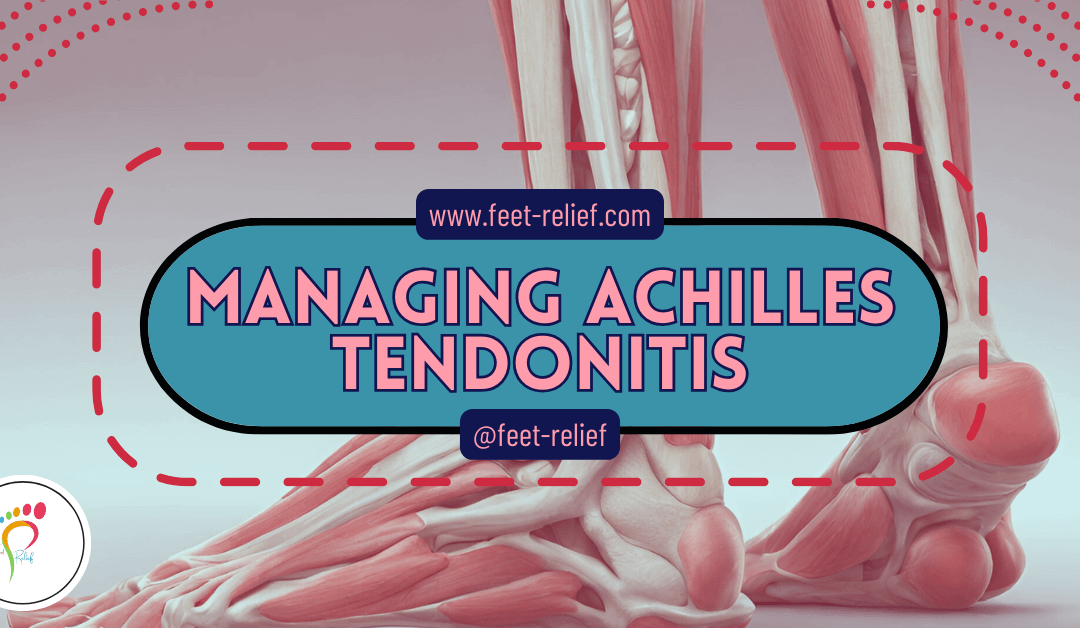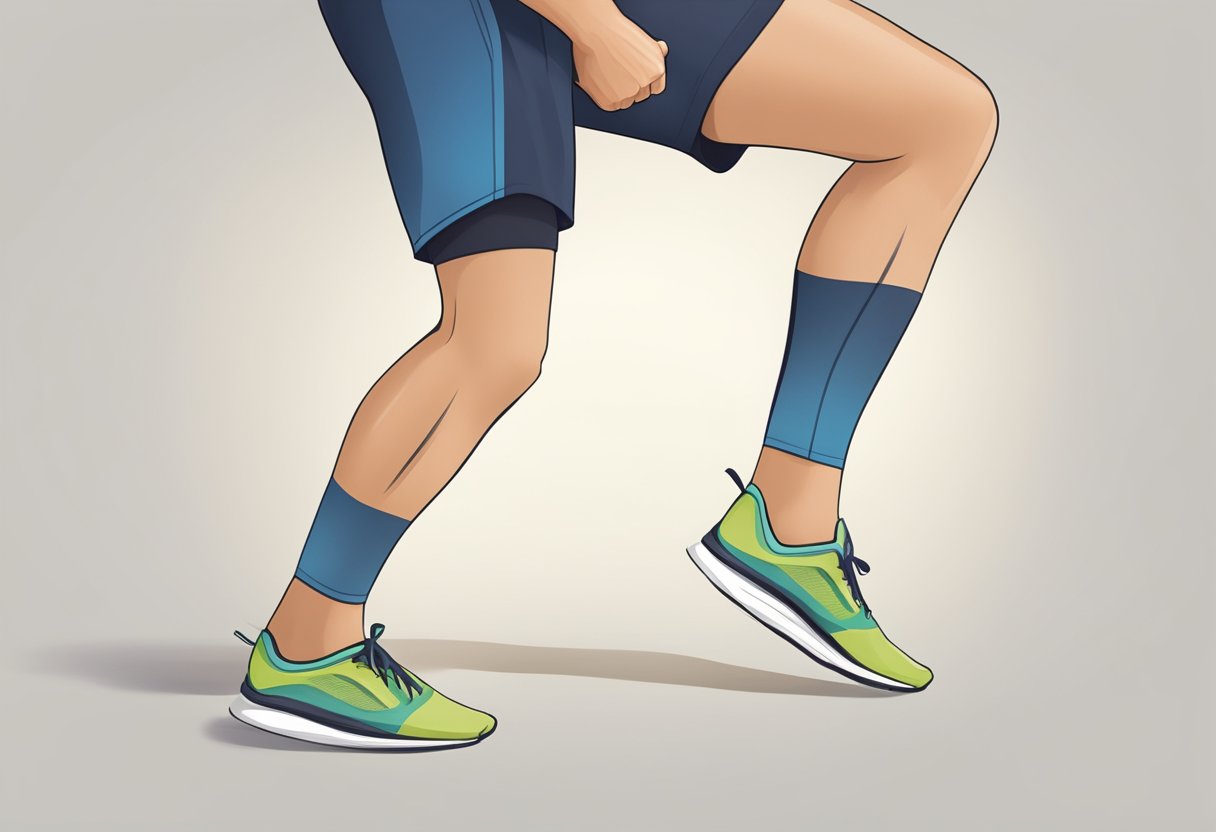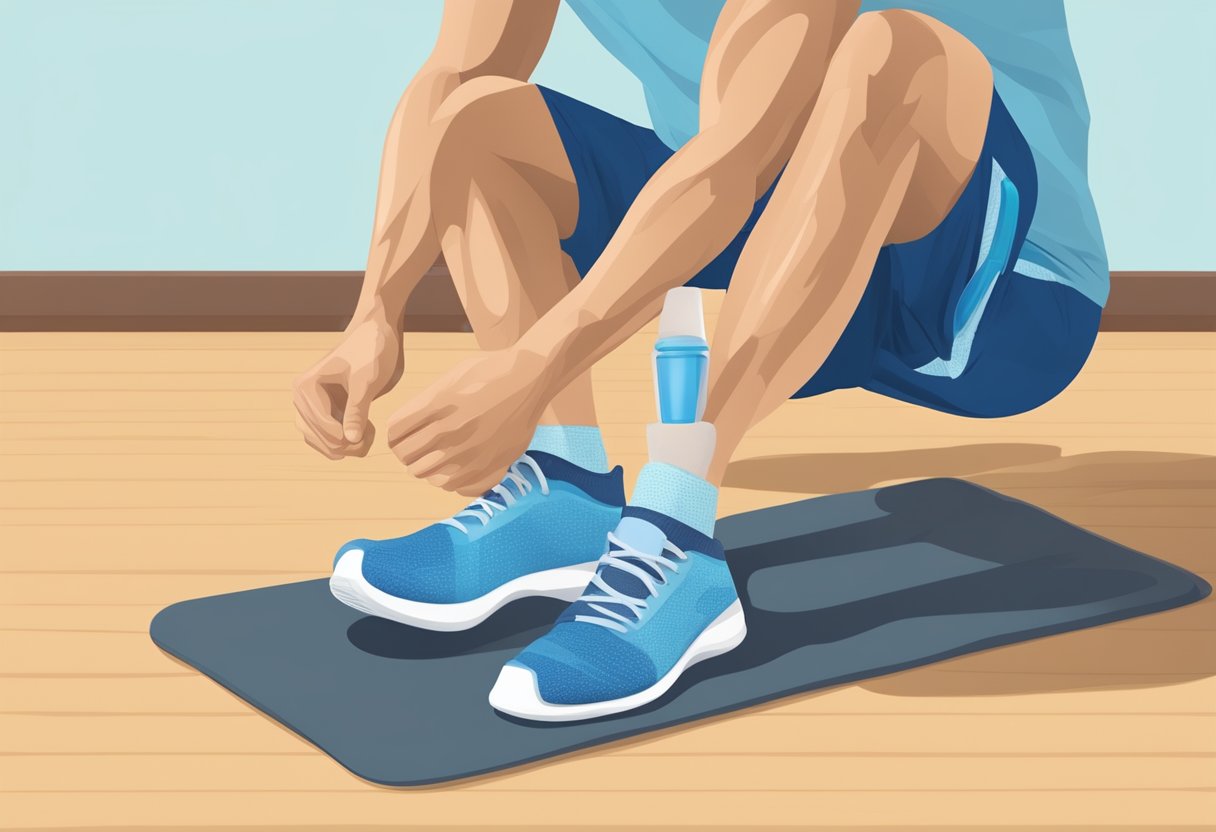Feet-Relief is supported by our audience. When you purchase through one of our links, we may earn a small affiliate commission. As an Amazon Associate I earn from qualifying purchases.Your cost is not affected.
Achilles tendonitis, an affliction that strikes at the core of our mobility, can be a formidable obstacle on the journey to an active and pain-free lifestyle. The Achilles tendon, the powerhouse connecting calf muscles to the heel, is a vital player in our daily movements, from walking and running to jumping. When this resilient tendon succumbs to inflammation, it signals discomfort that can disrupt the rhythm of our lives.
Understanding the nuances of Achilles tendonitis — its anatomy, causes, and symptoms — is the first step toward effective management. In this guide, we’ll explore strategies that strike a balance between rest, targeted exercises, and lifestyle adjustments, aiming not just to alleviate pain but to foster healing and prevent future injuries. Whether you’re grappling with the initial stages or seeking advanced interventions, this comprehensive approach offers a roadmap to navigate the challenges posed by Achilles tendonitis.
Managing Achilles Tendonitis: Effective Strategies for Pain Relief and Recovery
Achilles tendonitis is a common injury that affects the largest tendon in your body—the Achilles tendon. This tendon vital for walking, running, and jumping, connects your calf muscles to your heel bone. When it becomes inflamed, it can cause pain and discomfort that may disrupt your daily activities. Understanding what contributes to this tendinopathy and recognizing its symptoms are critical first steps in effectively managing this condition.
To manage Achilles tendonitis, it is essential to approach treatment with a balance of rest, targeted exercises, and lifestyle modifications. Strategies such as reducing activities that exacerbate symptoms, incorporating stretching and strengthening exercises, and using appropriate footwear can aid in alleviating pain and promoting healing. In some cases, more advanced treatment options may be necessary, and recognizing when to seek professional guidance can help prevent further injury and aid in a successful recovery.
Key Takeaways
- Achilles tendonitis involves inflammation of the tendon connecting the calf to the heel.
- Management includes rest, exercises, and appropriate footwear.
- Professional help may be needed for advanced treatments or persistent symptoms.

Understanding Achilles Tendonitis
Achilles tendonitis is a condition that requires proper knowledge of its anatomy, causes, and symptoms to manage effectively. Educating yourself on these aspects is vital for correct diagnosis and treatment.

Anatomy of the Achilles Tendon
Your Achilles tendon is a robust and fibrous band connecting the muscles in your calf to your heel bone. It’s the largest tendon in your body, designed to withstand great stresses from running and jumping, yet vulnerable to injury when overused or improperly loaded.
Causes of Achilles Tendonitis
Achilles tendonitis often results from repetitive stress to the tendon. This can occur due to a sudden increase in the intensity or duration of physical activity, tight calf muscles, or abnormal foot biomechanics. External factors like inadequate footwear can also contribute to the development of this condition.
Symptoms and Diagnosis
Common symptoms include pain and stiffness along the Achilles tendon in the morning, pain along the tendon or back of the heel that worsens with activity, and severe pain the day after exercising. Diagnosis is typically made through a physical examination, with imaging tests such as ultrasound or MRI used to rule out other conditions.
Treatment Strategies
Treating Achilles tendinitis involves a multi-faceted approach aimed at reducing pain, promoting tendon healing, and rebuilding strength to prevent future injury.

Initial Pain Management
To address the immediate discomfort from Achilles tendinitis, you should begin with rest and avoid activities that exacerbate the pain. This may include temporary cessation of running or other high-impact sports. Ice application for 20 minutes several times a day can help reduce inflammation and pain. Elevating your leg when possible can also assist with decreasing swelling. For added support, compression bandages or sleeves may be beneficial.
Physical Therapy and Rehabilitation
Engaging in physical therapy is a crucial step in recovery. A physical therapist can guide you through specific stretching and strengthening exercises that enhance healing and fortify the structures around the Achilles tendon. Eccentric strengthening exercises, which involve lengthening the muscle while contracting it, have shown particular effectiveness.
Medication and Supplements
Over-the-counter pain relievers like ibuprofen can be utilized to alleviate pain and reduce inflammation. However, they should be used sparingly and according to the manufacturer’s instructions. There is some evidence that suggests certain supplements might aid in recovery, though you should consult with a healthcare professional before starting any new medication or supplement regimen.

Preventive Measures
Preventing Achilles tendonitis involves a multifaceted approach, focusing on proper exercise techniques, suitable support through footwear, and nourishing your body with the right nutrients.
Exercise and Training Modifications
- Gradually Increase Activity: Avoid sudden spikes in exercise intensity or duration that can stress your Achilles tendon. Aim for a progressive increase in both mileage and pace.
- Strength Training: Incorporate exercises that strengthen the calf muscles, such as heel drops, to provide better support to your Achilles tendon. Refer to Achilles Tendonitis Prevention Methods for Runners for specific strength exercises.
Footwear and Support
- Proper Footwear: Choose shoes with adequate cushioning and arch support to reduce strain on the tendon. Footwear matters, so investing in the correct type can be a proactive step.
- Orthotic Devices: Consider using custom orthotic devices if you have foot conditions that contribute to tendon stress, such as overpronation or flat feet.
Nutrition and Lifestyle Factors
- Maintain a Healthy Weight: Extra weight can add unnecessary stress to your Achilles tendon, emphasizing the importance of a balanced diet to manage your body weight effectively.
- Anti-inflammatory Foods: Consume foods high in omega-3 fatty acids and antioxidants to help reduce inflammation in your body.
Advanced Treatment Options
When conservative treatments for Achilles tendinitis do not result in improvement, more advanced options may be considered. These include injection therapies and surgical interventions, each with specific indications and outcomes.
Injection Therapies
Injection therapies can provide targeted relief and facilitate healing in the Achilles tendon. Platelet-rich plasma (PRP) injections involve concentrating platelets from your blood and injecting them into the injured tendon area, promoting healing through growth factors. Another method, corticosteroid injections, can offer temporary pain relief; however, they are less favored due to potential risks of tendon weakening or rupture.
Surgical Interventions
Surgical options become viable when your tendon damage is severe or when there is a failed response to nonsurgical approaches. Gastrocnemius recession is a procedure intended to lengthen the calf muscles, reducing stress on the tendon. In cases where the tendon is severely damaged, tendon repair surgery may be necessary. This involves removing damaged sections of your Achilles tendon and possibly reconstructing the tendon using grafts.
Recovery and Prognosis
When managing Achilles tendinitis, your recovery time will vary depending on the severity of the condition and adherence to treatment protocols. Typically, with proper care, you can expect a steady improvement.
Immediate Steps:
- Rest: Give your tendon the necessary time off from activities that aggravate it.
- Ice: Apply ice to the affected area to reduce pain and swelling.
Rehabilitation Exercises:
- Calf Stretching: Regular stretching can enhance flexibility and lessen tension on your tendon.
- Strengthening Exercises: Once pain allows, gentle exercises to strengthen calf muscles are beneficial.
Medical Interventions:
- Medication: Anti-inflammatory drugs can help alleviate pain.
- Therapy: Consult a physiotherapist for personalized exercises and treatments.
Prognosis:
- Most cases of Achilles tendinitis resolve with conservative treatments within days to weeks.
- Persistent symptoms may require more advanced care, such as platelet-rich plasma injections.
- Shift to low-impact activities to prevent recurrence.

Your recovery hinges on listening to your body and following professional guidance. Patients who manage their activities and commit to their treatment often see positive outcomes. If symptoms persist or worsen, it is critical to seek further medical advice. Remember that returning to high-intensity activities should be gradual, allowing your tendon to adapt and strengthen.
When to Seek Professional Help
If you’re dealing with Achilles tendonitis, recognizing when to seek medical attention is crucial. Here are specific situations where professional help is needed:
- Persistent Pain: If your Achilles pain does not improve after a few days of self-care, including rest, icing, and over-the-counter pain relief.
- Severe Symptoms: Sharp or unbearable pain, especially if it occurs suddenly or without an injury, warrants immediate medical consultation.
- Impaired Functionality: Difficulty walking or an inability to stand on your toes are indicators that a professional assessment is necessary.
- Recurrent Issues: Frequent episodes of tendonitis, even if they seem to resolve with rest, should be evaluated to determine the underlying cause.
Visual or Physical Changes: Noticeable swelling, redness, or warmth around the tendon, or any deformity in the area could suggest a more severe condition like a tendon rupture.
| Symptom | Action Required |
|---|---|
| Persistent Pain | Schedule an appointment with a healthcare provider |
| Severe Symptoms | Seek immediate medical care |
| Impaired Functionality | Consult a healthcare provider for an evaluation |
| Recurrent Issues | Visit a specialist for a full assessment |
| Visual or Physical Changes | Obtain urgent medical attention |
For guidance on self-management and additional information, you can also refer to self-manage your Achilles tendon pain. But remember, if your symptoms are not improving or worsening, do not hesitate to see a healthcare professional.
Conclusion
In managing Achilles tendonitis, a combination of patience, self-awareness, and professional guidance is key to a successful recovery. Remember that your body communicates its needs, and listening to it is paramount. Consistent adherence to treatment protocols, including rest, appropriate exercises, and lifestyle modifications, can pave the way for positive outcomes.

Recovery times vary, and progress may be gradual, but with proper care, improvement is likely. Your commitment to the prescribed interventions, whether through rest, physical therapy, or advanced treatments if needed, plays a crucial role in your journey towards healing.
If symptoms persist or worsen, don’t hesitate to seek professional help. Understanding when to consult a healthcare provider is crucial for timely and effective intervention. Trust your instincts and be proactive in addressing persistent pain, severe symptoms, impaired functionality, recurrent issues, or any visual changes around the Achilles tendon.
In your pursuit of a full recovery, remember that everyone’s path is unique. Embrace the journey, be kind to yourself, and know that with the right approach, managing Achilles tendonitis can lead to restored strength and a return to the activities you love.
Frequently Asked Questions
In this section, you’ll find targeted information addressing common concerns about managing Achilles tendonitis, ranging from exercise recommendations to identifying symptoms.
What exercises are recommended for strengthening the Achilles tendon?
Strengthening the Achilles tendon is vital for recovery and prevention of Achilles tendonitis. Your focus should be on gentle calf raises, eccentric heel drops, and toe-to-wall stretches that promote tendon health without excessive strain.
Why might Achilles tendonitis persist despite treatment efforts?
Persistent Achilles tendonitis can be due to several factors, such as inadequate rest, returning to high-impact activities too quickly, or not fully adhering to rehabilitation protocols. Ensure you’re allowing adequate time for recovery and following professional medical advice.
What should you do if you discover a lump on your Achilles tendon?
If you notice a lump on your Achilles tendon, it’s important to consult a healthcare provider as soon as possible. This could be a sign of a tendon injury, such as tendinopathy or a partial tear.
How can one effectively treat a sore Achilles tendon?
To effectively treat a sore Achilles tendon, adhere to the RICE protocol – Rest, Ice, Compression, and Elevation. Over-the-counter pain relievers may also help, but consulting with a healthcare provider for personalized treatment is crucial.
Which symptoms indicate the presence of Achilles tendonitis?
Symptoms include a mild ache in the back of the leg or above the heel, which may worsen after running or climbing stairs. More severe pain after sustained activity could also indicate the presence of Achilles tendonitis.
What are the best practices for stretching when dealing with Achilles tendonitis?
For Achilles tendonitis, it’s recommended to perform stretches that are gentle and focused on the calf muscles. Static stretches held for 15-30 seconds, without bouncing, can help increase flexibility and reduce tension on the tendon.
Introducing Feet-Relief.com – Elevate Your Foot Care Journey!
Explore tailored foot care solutions for all ages.
Expert advice and quality products for elderly foot care.
Discover tips, routines, and a supportive community.
Shop now for comfort at Feet-Relief.com!
Your feet, your comfort – we’ve got you covered!
Amazon and the Amazon logo are trademarks of Amazon.com, Inc, or its affiliates.






